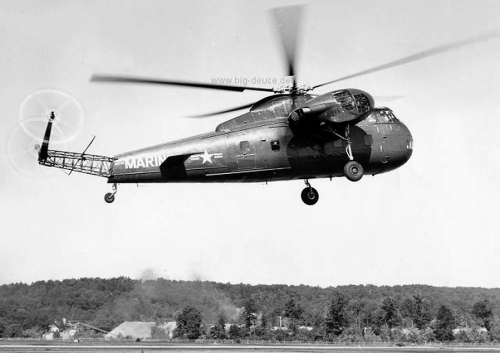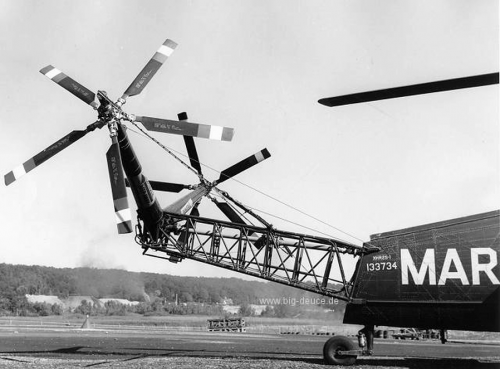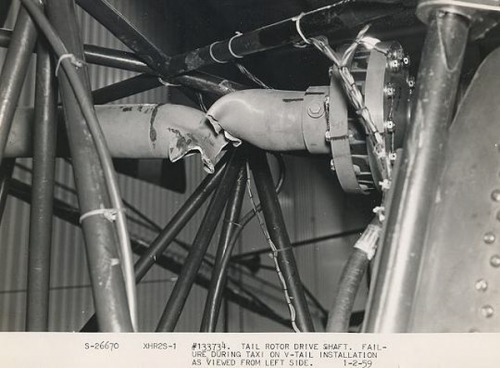- Joined
- 1 May 2007
- Messages
- 2,595
- Reaction score
- 1,965
From The 'Big Deuce' site :-
http://www.big-deuce.de/d_story05.htm
"The prototype XHR2S-1, USMC No. 133734, was modified to have a "V"-tail with two tail rotors. The original version using two four-bladed tail rotors first flew on March 2, 1956. Subsequently, two five-bladed tail rotors were flown on April 11, 1956. The rationale for this modification was to increase the center-of-gravity range and allow more indiscriminate loading. With two canted tail rotors, the individual tail rotor thrusts could be adjusted to provide both the required anti-torque thrust and different levels of lift. In this way, centers-of-gravity that were further forward or further aft could be compensated for by decreasing or increasing the combined tail rotor lift component by retaining the same anti-torque sideforce. The project was successful but never adopted for production. My guess is that the additional weight and power required were too high to make the system viable."
and from :-
http://www.big-deuce.de/d_story08.htm
"The first twin tail rotor version was using S-58 4-bladed tail rotors. It flew okay, but the rotors were a bit short on thrust to do the job, hence they were replaced by the bigger 5-bladed S-61 rotors . These worked just fine, but because they had straight flapping hinges, the blades tended to stay on the blade stops in some flight conditions, creating too much stress, so they were then replaced with rotors having 10-degree Delta hinges (to cross-couple the pitch and flap motion so they would stay centered better).
However, the main problem with the concept was the autorotation. Since the tail rotor blades couldn't be 'feathered' (which is automatically the case with a vertical tail rotor), the excess drag in descent tended to reduce the main rotor RPM continuously until control would be lost. I had the crew lower the collective pitch stop down a full 8 degrees of lower main rotor blade angle, but then the rate of descent was too much to recover to a safe flare-out and landing. Anyway, the in-flight separation of the right tail rotor ended that project!
Some of the fun happenings during flight testing. Story goes like this:
734: 'Tower, 734 ready to taxi to the runway'
twr: 'Roger, 734 cleared to the runway - wind 040 at 7, altimeter 2988'
734: 'Roger, 734 cleared'
ics: 'all set Hollis?'
ics: 'ready to go"
(later):...
734: '734 ready for take-off'
twr: Roger - advise your tail rotors aren't turning - is that normal?'
734: ' I don't think so - standby'
ics: (Hollis) - 'hold it right there, let me take a look'...
ics: (Hollis) - 'I'll be damned - no rotation either rotor - shut 'er down. I guess we'll need a tow back in'.
734: 'Tower, 734 is shutting down - would you call for the tug? We need a tow!.
twr: 'Roger 734 - do you need the crash crew for assistance?'
734: 'Negative, maybe call a cab for us! - ..
(Everyone laughs).."
cheers,
Robin.
http://www.big-deuce.de/d_story05.htm
"The prototype XHR2S-1, USMC No. 133734, was modified to have a "V"-tail with two tail rotors. The original version using two four-bladed tail rotors first flew on March 2, 1956. Subsequently, two five-bladed tail rotors were flown on April 11, 1956. The rationale for this modification was to increase the center-of-gravity range and allow more indiscriminate loading. With two canted tail rotors, the individual tail rotor thrusts could be adjusted to provide both the required anti-torque thrust and different levels of lift. In this way, centers-of-gravity that were further forward or further aft could be compensated for by decreasing or increasing the combined tail rotor lift component by retaining the same anti-torque sideforce. The project was successful but never adopted for production. My guess is that the additional weight and power required were too high to make the system viable."
and from :-
http://www.big-deuce.de/d_story08.htm
"The first twin tail rotor version was using S-58 4-bladed tail rotors. It flew okay, but the rotors were a bit short on thrust to do the job, hence they were replaced by the bigger 5-bladed S-61 rotors . These worked just fine, but because they had straight flapping hinges, the blades tended to stay on the blade stops in some flight conditions, creating too much stress, so they were then replaced with rotors having 10-degree Delta hinges (to cross-couple the pitch and flap motion so they would stay centered better).
However, the main problem with the concept was the autorotation. Since the tail rotor blades couldn't be 'feathered' (which is automatically the case with a vertical tail rotor), the excess drag in descent tended to reduce the main rotor RPM continuously until control would be lost. I had the crew lower the collective pitch stop down a full 8 degrees of lower main rotor blade angle, but then the rate of descent was too much to recover to a safe flare-out and landing. Anyway, the in-flight separation of the right tail rotor ended that project!
Some of the fun happenings during flight testing. Story goes like this:
734: 'Tower, 734 ready to taxi to the runway'
twr: 'Roger, 734 cleared to the runway - wind 040 at 7, altimeter 2988'
734: 'Roger, 734 cleared'
ics: 'all set Hollis?'
ics: 'ready to go"
(later):...
734: '734 ready for take-off'
twr: Roger - advise your tail rotors aren't turning - is that normal?'
734: ' I don't think so - standby'
ics: (Hollis) - 'hold it right there, let me take a look'...
ics: (Hollis) - 'I'll be damned - no rotation either rotor - shut 'er down. I guess we'll need a tow back in'.
734: 'Tower, 734 is shutting down - would you call for the tug? We need a tow!.
twr: 'Roger 734 - do you need the crash crew for assistance?'
734: 'Negative, maybe call a cab for us! - ..
(Everyone laughs).."
cheers,
Robin.



